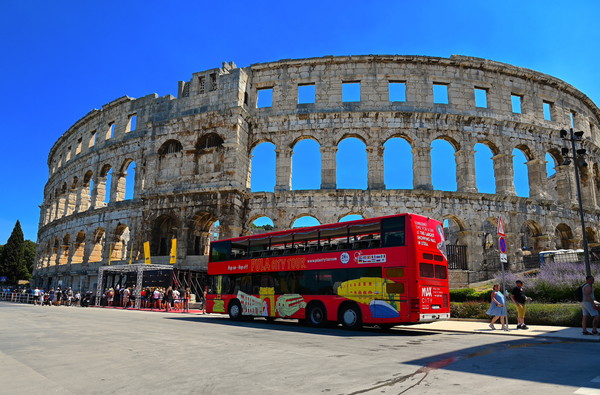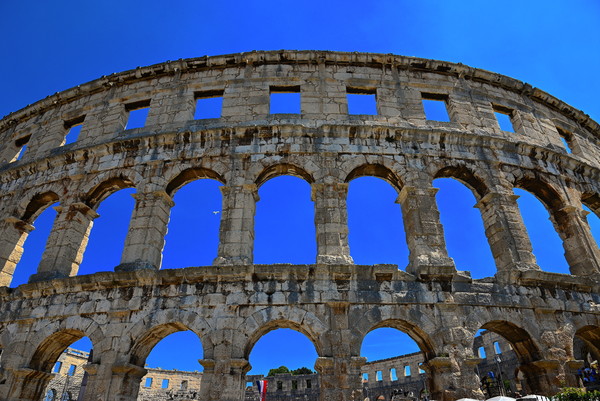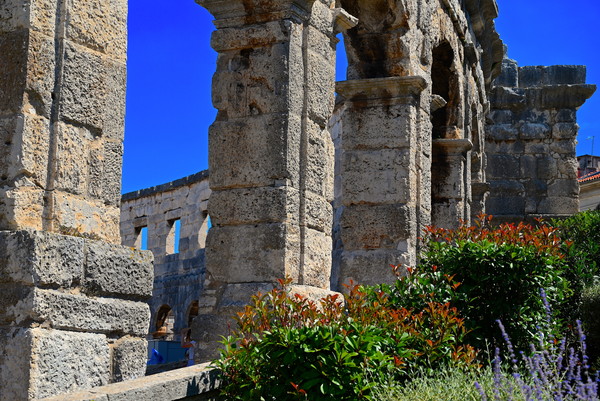The Roman Amphitheatre in Pula

[아츠앤컬쳐] 풀라는 크로아티아 북서부의 이스트리아 반도에서 가장 큰 도시이며, 잘 보존된 로마 유산, 아름다운 아드리아 해안선, 풍부한 해양 역사로 잘 알려져 있다. 풀라는 문화, 경제, 역사상 중요한 해군의 중심지일 뿐만 아니라 그림 같은 구시가지, 아름다운 해변, 활기찬 축제와 문화 행사가 열리는 인기 있는 관광지이기도 하다.
풀라 아레나로도 알려진 풀라의 원형극장은 의심할 여지 없이 도시에서 가장 유명하고 중요한 기념물로, 세계에서 가장 크고 잘 보존된 로마 원형극장 6곳 중 하나다. 다른 많은 원형극장들과 달리, 이 건물은 네 개의 측면 탑과 대부분의 외벽이 희귀하고 놀라울 정도로 원형 그대로 잘 보존된 건축 구조물이다. 풀라 원형극장은 기원전 1세기 후반 아우구스투스 황제 때 짓기 시작하여, 서기 1세기 로마 콜로세움을 의뢰한 베스파시아누스 황제 때 제국 내에서 풀라의 중요성을 높이고자 경기장을 확장했다.
로마 제국의 다른 지역과 마찬가지로, 그 주요 목적은 검투사 대회와 대중의 구경거리를 위한 것이었으며, 이는 로마 시민들을 매료시키는 오락의 한 형태였다. 주로 현지 석회암으로 지어진 원형 경기장은 최대 23,000명의 관중을 수용할 수 있었다. 중세 시대에는 아레나 내부가 가축 방목뿐만 아니라 가끔 기사 대회나 박람회를 위한 장소로 쓰였고, 베네치아와 합스부르크 시대에는 곡물과 와인과 같은 농산물의 창고 역할을 했으며, 오스트리아-헝가리 제국하에서는 군사용 및 기타 기능으로 일부 용도가 변경되었다. 오늘날 이 경기장은 주로 문화적 장소로, 콘서트, 오페라, 연극 공연이 거행되며, 1954년부터는 매년 세계적으로 유명한 풀라 영화제도 개최되고 있다.

풀라 아레나는 타원형으로 길이 약 132미터, 폭 105미터, 높이 최대 32.5미터에 달한다. 이 경기장은 네 개 층으로 구성되어 있으며, 첫 번째 층은 자연광과 환기를 가능하게 하는 큰 아치형 개구부를 특징으로 한다. 최고층은 원래 관람객을 위한 그늘을 제공하는 목조 구조물이었다. 다른 많은 로마 원형경기장과 달리, 풀라 아레나는 독특하게도 외벽이 완전히 보존된 가장 온전한 구조물 중 하나다. 경기장 바닥 아래에는 한때 검투사, 동물, 무대 장비 등이 있던 지하 통로와 방들이 줄지어 있다. 원형 극장의 설계는 뛰어난 음향 성능을 보장하여 현대 공연을 위한 용도 변경도 가능하다.
풀라에는 원형극장뿐만 아니라 여러 중요한 로마 및 역사적 랜드마크가 있다. 도시의 고대 포럼에는 서기 1세기의 아우구스투스 신전이 있고, 기원전 29~27년경에 지어진 세르기의 아치는 저명한 로마 가문을 기념한다. 또한, 쌍둥이 문과 성벽, 작은 로마 극장 등 옛 방어 시스템의 흔적도 남아 있다.
풀라의 원형극장은 로마의 건축적 독창성과 문화적 회복력을 보여주는 놀라운 증거다. 이곳에서 아레나의 숨막히는 음향과 분위기를 활용해 엘튼 존, 두아 리파, 스팅, 루치아노 파바로티, 듀란 듀란, 안드레아 보첼리 등 유명 아티스트들이 공연이 열렸다. 대중의 관람을 위한 웅장한 아레나에서 시작하여 현대적인 문화적 장소로서의 역할까지, 이곳은 역사적인 보물이자 크로아티아 최고의 관광 명소 중 하나다.
번역 주한 크로아티아 대사관 양지윤

The Roman Amphitheatre in Pula
Pula is the largest city in the Istrian Peninsula, situated in the northwestern part of Croatia. It is best known for its well-preserved Roman heritage, stunning Adriatic coastline, and rich maritime history. In addition to being an important cultural, economic, and naval center throughout history, Pula is also a popular tourist destination with a picturesque old town, beautiful beaches, and vibrant festivals and cultural events.
The Amphitheatre of Pula, also known as the Pula Arena, is undoubtedly the most famous and significant monument in the heart of the town. It is one of the six largest and best-preserved Roman amphitheaters in the world. Unlike many others, it has retained all four original side towers and most of its outer walls, making it a rare and remarkably well-preserved architectural structure.

The construction of the Pula Amphitheatre began during the reign of Emperor Augustus in the late 1st century BC and was expanded under Emperor Vespasian in the 1st century AD. Vespasian, known for commissioning the Colosseum in Rome, sought to enhance Pula’s significance within the empire, leading to the arena’s enlargement.
As in other parts of the Roman Empire, its primary purpose was to host gladiatorial contests and public spectacles, a form of entertainment that fascinated Roman citizens. Built primarily from local limestone, the amphitheatre could accommodate up to 23,000 spectators. In the Middle Ages, the interior of the Arena was often used for grazing livestock, as well as for occasional knights' tournaments and medieval fairs. During the Venetian and Habsburg periods, the Pula Arena served as a warehouse for agricultural goods like grain and wine. Under the Austro-Hungarian Empire, parts of it were repurposed for military use and other functions. Today, the arena is primarily a cultural venue, hosting concerts, operas, theatrical performances, and the world-famous Pula Film Festival, held annually since 1954.

The Pula Arena is elliptical in shape, measuring approximately 132 meters in length and 105 meters in width, with a height of up to 32.5 meters. It consists of four levels, with the first three featuring large arched openings that allow natural light and ventilation. The top tier originally had wooden structures providing shade for spectators. Unlike many other Roman amphitheaters, the Pula Arena uniquely retains its complete outer wall, making it one of the most intact structures of its kind. Beneath the arena floor, a series of underground passages and rooms once housed gladiators, animals, and stage machinery. The amphitheater's design ensured excellent acoustics, which has enabled its repurposing for modern performances.
Beyond the Amphitheatre, Pula is home to several other significant Roman and historical landmarks. The Temple of Augustus, a well-preserved 1st-century AD temple, stands in the city’s ancient Forum. The Arch of the Sergii, built around 29–27 BC, commemorates a prominent Roman family. Pula also features remnants of its old defensive system, including the Twin Gates and City Walls, and the Small Roman Theatre.
The Amphitheatre in Pula is a remarkable testament to Roman architectural ingenuity and cultural resilience. Renowned artists such as Elton John, Dua Lipa, Sting, Luciano Pavarotti, Duran Duran, Andrea Bocelli, and many others have performed here, taking advantage of the Arena’s breathtaking acoustics and atmosphere. From its origins as a grand arena for public spectacles to its modern role as a cultural venue, it remains a historic treasure and one of Croatia’s top tourist attractions.

글 Loreta Bertosa-Kusen
Minister Plenipotentiary
Embassy of Croatia, London

